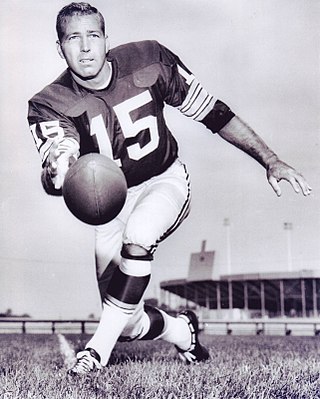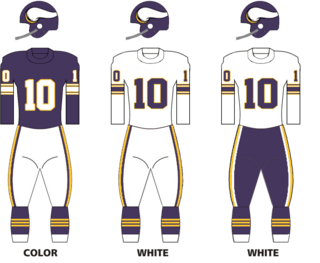Related Research Articles

Paul Vernon Hornung, nicknamed "the Golden Boy", was an American football halfback and kicker who played for the Green Bay Packers of the National Football League (NFL) from 1957 to 1966. He played on teams that won four NFL titles and the first Super Bowl. He is the first Heisman Trophy winner to win the NFL Most Valuable Player award, and be inducted into both the Pro Football Hall of Fame and College Football Hall of Fame. Packers coach Vince Lombardi stated that Hornung was "the greatest player I ever coached".

Bryan Bartlett Starr was an American professional football quarterback and head coach for the Green Bay Packers of the National Football League (NFL). He played college football for the Alabama Crimson Tide, and was selected by the Packers in the 17th round of the 1956 NFL draft, for whom he played for 16 seasons until 1971. Starr is the only quarterback in NFL history to lead a team to three consecutive league championships (1965–1967). He led his team to victories in the first two Super Bowls: I and II. As the Packers' head coach, he was less successful, compiling a 52–76–3 (.408) record from 1975 through 1983.

William Vernell Wood Sr. was an American professional football player and coach. He played as a safety with the Green Bay Packers in the National Football League (NFL). Wood was an eight-time Pro Bowler and a nine-time All-Pro. In 1989, Wood was elected to the Pro Football Hall of Fame.
Earl Roy Gros was an American football running back who played in the National Football League (NFL) for nine seasons. Born and raised in Louisiana, he played college football at Louisiana State University (LSU) in Baton Rouge.
The 1965 NFL playoffs determined the champion of the National Football League in professional American football for its 1965 season. Although a single championship game between conference winners was the current format for the league, a tie in the Western Conference standings between the Green Bay Packers and Baltimore Colts necessitated a rare tiebreaker playoff, the first in the league in seven years and the first in the Western conference since 1957. A coin flip decided the home team. The teams had played twice during the regular season and Green Bay had won both: 20–17 in Milwaukee on September 26, and 42–27 in Baltimore on December 12.
James Grabowski is an American former football player and broadcaster. He played as a running back in the National Football League (NFL), primarily with the Green Bay Packers.

Edmund Raymond "Zeke" Bratkowski was an American professional football player who was a quarterback in the National Football League (NFL) for 14 seasons with the Chicago Bears, Los Angeles Rams, and Green Bay Packers.
MacArthur Lane was an American professional football player who was a running back in the National Football League (NFL) for eleven seasons, from 1968 to 1978 for the St. Louis Cardinals, Green Bay Packers, and Kansas City Chiefs.

The 1966 Green Bay Packers season was their 48th season overall and their 46th in the National Football League (NFL). The defending NFL champions had a league-best regular season record of 12–2, led by eighth-year head coach Vince Lombardi and quarterback Bart Starr, in his eleventh NFL season.
The 1967 Green Bay Packers season was their 49th season overall and their 47th season in the National Football League (NFL) and resulted in a 9–4–1 record and a victory in Super Bowl II. The team beat the Dallas Cowboys in the NFL Championship Game, a game commonly known as the "Ice Bowl," which marked the second time the Packers had won an NFL-record third consecutive NFL championship, having also done so in 1931 under team founder Curly Lambeau. In the playoff era, it remains the only time a team has won three consecutive NFL titles.
Lee Roy Caffey was an American professional football player who was an outside linebacker in the National Football League (NFL) for the Philadelphia Eagles, Green Bay Packers, Chicago Bears, Dallas Cowboys and San Diego Chargers. Caffey is one of the top 100 Green Bay Packers of All-Time (#57). Caffey and teammates, Ray Nitchke and Dave Robinson, were named one of the top 10 best linebacking trios in the history of the NFL by ESPN. He played college football for the Texas A&M Aggies and is one of Texas A&M’s top 10 best players in the NFL.
Robert DeLafayette Jeter, Jr. was an American football cornerback in the National Football League (NFL) for the Green Bay Packers and the Chicago Bears.

The 1964 season was the Minnesota Vikings' fourth in the National Football League. Under head coach Norm Van Brocklin, the team finished with an 8–5–1 record for their first winning season and a franchise-best until 1969. They tied with the Green Bay Packers for second place in the Western conference, who gained the berth in the third-place Playoff Bowl in Miami on January 3. The two teams had split their season series, with the road teams winning, but the Packers won the tiebreaker on point differential: the Vikings' victory was by just one point, while Green Bay won by over four touchdowns. In the season opener, the Vikings upset eventual Western champion Baltimore.
Tom Moore is an American former professional football player who was a running back for eight seasons in the National Football League (NFL) for eight seasons, the first six with the Green Bay Packers. He played college football for the Vanderbilt Commodores. He went to the Pro Bowl after Green Bay's 1962 season and later played for the Los Angeles Rams and Atlanta Falcons.
Douglas Wayne Hart was a professional American football player, a defensive back who played eight seasons for the Green Bay Packers of the National Football League.
The 1972 Green Bay Packers season was their 54th season overall and their 52nd season in the National Football League. The team finished with a 10–4 record under second-year head coach Dan Devine, earning them the NFC Central division title. The Packers returned to the playoffs after a four-year drought ; their most recent division title was in 1967, completing that postseason with a decisive win in Super Bowl II in January 1968.
The 1970 Green Bay Packers season was their 52nd season overall and their 50th season in the National Football League. The team finished with a 6–8 record earning them a third consecutive third-place finish in the four-team NFC Central division. It was the third and final season for Phil Bengtson as head coach; he resigned shortly after the season ended.
The 1963 Green Bay Packers season was their 45th season overall and their 43rd season in the National Football League. The two-time defending NFL champions finished with an 11–2–1 record under fifth-year head coach Vince Lombardi for a second-place finish in the Western Conference, a half game back.
The 1965 Green Bay Packers season was their 47th season overall and their 45th season in the National Football League. The team finished with a 10–3–1 record under seventh-year head coach Vince Lombardi, earning a tie for first place in the Western Conference with the Baltimore Colts.
John Gipson Roach was an American professional football player who was a quarterback and defensive back in the National Football League (NFL) for the Chicago/St. Louis Cardinals, Green Bay Packers, and Dallas Cowboys. He played college football for the SMU Mustangs.
References
- 1 2 Johnson, Chuck (November 29, 1964). "1st round future a Packer 1st". Milwaukee Journal. p. 1, sports. Archived from the original on April 16, 2016. Retrieved May 18, 2015.
- ↑ Foster, Dan (July 2, 1975). "Donny Anderson" . The Greenville News. Greenville, South Carolina – via newspapers.com.
- ↑ Cross, Ron (December 30, 1965). "Rambling With Red" . Pampa Daily News. Pampa, Texas – via newspapers.com.
- 1 2 Lea, Bud (February 4, 1966). "Donny excelled in all sports". Milwaukee Sentinel. p. 2-part 2. Archived from the original on May 13, 2016. Retrieved November 17, 2015.
- 1 2 Beilue, Jon Mark (December 26, 1999). "'The best college football player in America'". Amarillo Globe-News. Retrieved January 9, 2014.
- ↑ Lea, Bud (February 5, 1966). "'Packers biggest challenge'". Milwaukee Sentinel. p. 1-part 2.
- ↑ "Garrett, Anderson top All-America list". Spartanburg (SC) Herald. December 2, 1965. p. 42.
- ↑ "1965 Heisman Trophy voting". Sports Reference. Retrieved January 10, 2014.
- ↑ "Garrett captures Heisman Trophy". News and Courier. Charleston, SC. Associated Press. November 24, 1965. p. 1C.
- ↑ "Green Bay drafts 9 backs, 10 futures". Milwaukee Sentinel. November 30, 1964. p. 3-part 2.
- ↑ Lea, Bud (February 3, 1966). "How Packers landed a star". Milwaukee Sentinel. p. 2-part 2.
- ↑ "Donny Anderson Stats | College Football at". Sports-reference.com. Archived from the original on August 8, 2014. Retrieved July 14, 2014.
- ↑ "Texas Tech, yearly results". College Football Data Warehouse. 1965-69. Archived from the original on January 10, 2014. Retrieved January 19, 2014.
- ↑ "Anderson signs up with Pack". Milwaukee Sentinel. Associated Press. January 1, 1966. p. 1-part 2.
- ↑ "Anderson to Pack?". Associated Press. December 31, 1965. p. 8-part 2.
- ↑ "Anderson, Grabowski have to fit usual Green Bay mold, says coach". Tuscaloosa News. Associated Press. January 5, 1966. p. 16.
- ↑ Lea, Bud (August 6, 1966). "Packers roll over Stars, 38-0". Milwaukee Sentinel.
- ↑ Maule, Tex (September 12, 1966). "On with the golden game". Sports Illustrated: 53.
- ↑ "Jim Grabowski quits pro ball". Bryan Times. UPI. September 2, 1972. p. 7.
- ↑ Daley, Arthur (January 17, 1967). "Did it prove anything?". Nashua (NH) Telegraph. (New York Times). p. 10.
- ↑ Lea, Bud (January 16, 1967). "Packers 'Super' in routing Chiefs". Milwaukee Sentinel. p. 1-part 2. Archived from the original on May 14, 2016. Retrieved November 17, 2015.
- ↑ "Cards, Pack make swap of 2 backs". Spokane Daily Chronicle. (Washington). Associated Press. February 22, 1972. p. 19.
- ↑ Johnson, Chuck (November 7, 1973). "Shuffled off to St. Louis, Anderson scores as a Card". Milwaukee Journal. p. 14-part 2.
- ↑ Lea, Bud (February 23, 1972). "Donny tells of rift with Devine". Milwaukee Sentinel. p. 1-part 2.
- ↑ Williams, Gene (August 14, 1975). "Donny Anderson won't hang on". Miami News. p. 1C.
- ↑ "Donny Anderson quits Dolphins". Bangor Daily News. Associated Press. August 15, 1975. p. 9.
- ↑ "Donny Anderson calls it quits". Milwaukee Sentinel. wire services. August 15, 1975. p. 1, part 2.
- ↑ "Anderson, Jaynes leave pro ranks". Milwaukee Journal. press dispatches. August 15, 1975. p. 7, part 2.
- ↑ "Donny Anderson Stats, Height, Weight, Position, Draft, College". Pro-Football-Reference.com .
- ↑ Christl, Cliff. "Donny Anderson". Packers.com. Archived from the original on May 23, 2023. Retrieved September 20, 2023.
- ↑ Zeller, Ricky (April 14, 2011). "Where are they now? Donny Anderson is on the golf course". Packers.com. Retrieved January 9, 2014.
- ↑ Bryce, Charles (October 13, 2013). "Golf: Anderson recalls 'Ice Bowl,' Texas Tech days". San Angelo Standard-Times. Retrieved January 10, 2014.
- ↑ "About us". Winners for Life. Retrieved January 10, 2014.